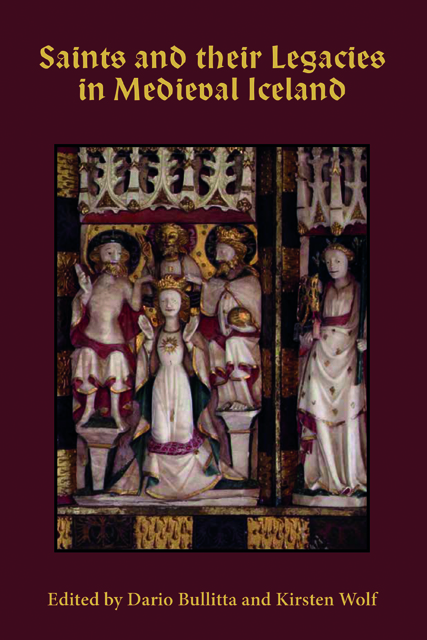Book contents
- Frontmatter
- Contents
- List of Illustrations
- List of Contributors
- Acknowledgments
- List of Abbreviations
- Introduction: The Splendor of the Saints
- Rannsǫkun Heilagra Bóka: The Search for Holy Books
- Heilagir Byskupar: Holy Bishops
- Heilagir Karlar ok Englar: Holy Men and Angels
- Heilagar Meyjar: Holy Maidens
- Bibliography
- Index of Manuscripts
- General Index
- Studies in Old Norse Literature
1 - Medieval Icelandic Hagiography: The State of the Art
Published online by Cambridge University Press: 14 January 2023
- Frontmatter
- Contents
- List of Illustrations
- List of Contributors
- Acknowledgments
- List of Abbreviations
- Introduction: The Splendor of the Saints
- Rannsǫkun Heilagra Bóka: The Search for Holy Books
- Heilagir Byskupar: Holy Bishops
- Heilagir Karlar ok Englar: Holy Men and Angels
- Heilagar Meyjar: Holy Maidens
- Bibliography
- Index of Manuscripts
- General Index
- Studies in Old Norse Literature
Summary
In each and every field or discipline, it is advisable now and then to pause and take stock, and this is the purpose of this article. More specifically, the aim is to survey and assess published research within the field of medieval Icelandic hagiography. The goal is two-fold: on the one hand, it seeks to celebrate the work that has been done, and on the other, it seeks to draw attention to the work that remains to be done.
The first editorial phase
Interest in and scholarship on hagiography within the field of Old Norse and early modern Icelandic may be divided broadly into three phases. The first phase comprises the late nineteenth century and the early twentieth century. The beginning is associated primarily with the impressive scholarly output of Carl Richard Unger (1817–1897), lecturer (1851–1862) and later professor (1862–1897) of Germanic and Romance Philology at the University of Christiania (Oslo). Prior to his appointment at the University of Christiania, Unger did research in Copenhagen, Paris, and London. In the course of his long career, Unger published numerous editions of Old Norse-Icelandic literary works. Mention may be made of, for example, Alexanders saga (1848), Karlamagnúss saga (1860), Stjórn (1862), Morkinskinna (1867), and Heimskringla (1868). He collaborated with Alex C. Drolsum (1846–1927) on Codex Frisianus (1871), with Rudolf Keyser (1803–1864) on Óláfs saga helga (1849) and Barlaams saga ok Jósafats (1851), with Keyser and Peter Andreas Munch (1810–1863) on Konungs skuggsjá (1848), and with Guðbrandur Vigfússon on (1827–1889) Flateyjarbók (1860–1868).
Towards the end of his career, Unger turned to Old Norse-Icelandic hagiography and published single-handedly and in rapid succession an edition of Thómass saga erkibyskups, the legend of St Thomas Becket (1869); an edition of Maríu saga ok jarteignir, the life and miracles of the Virgin Mary (1871); an edition of Postula sǫgur, a collection of various recensions of the legends about the Apostles (1874); and a two-volume edition of Heilagra manna sǫgur, a collection of more than three dozen legends and lives of the saints (1877).
- Type
- Chapter
- Information
- Saints and their Legacies in Medieval Iceland , pp. 11 - 28Publisher: Boydell & BrewerPrint publication year: 2021

